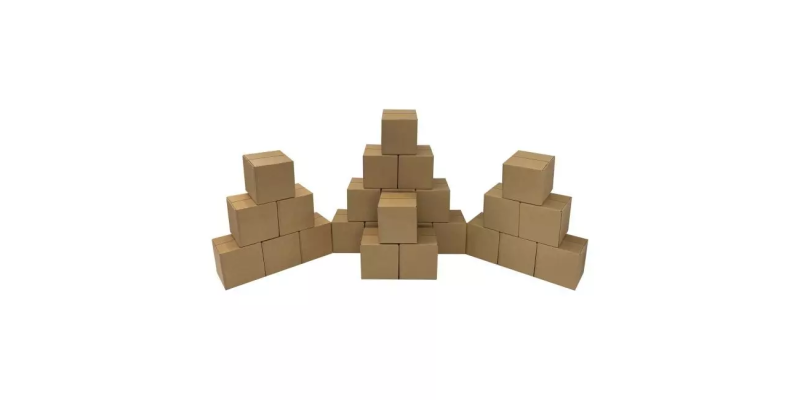In the world of packaging, understanding the differences between mailing boxes and shipping boxes is crucial for businesses and consumers alike. As the demand for packaging keeps growing globally, the corrugated box market valued at USD 269.7 billion in 2022 is estimated to expand at a 4.5% CAGR through 2030, making the need for efficient packaging solutions more evident. E-commerce, which made up 19% of global retail sales in 2022, is set to increase to 25% by 2027, further fueling the demand for shipping packaging.
In this article, we will learn about the key differences between a mailing box and a shipping box, looking at factors like durability, size, and specific use cases. Additionally, we’ll go in-depth into alternative packaging options like poly mailers and bubble mailers, all contributing to the growing trend of corrugated box usage for secure shipping and cost-effective packaging solutions.
Why Packaging Choice Matters?
Packaging choices significantly influence various aspects of business, from product protection to customer perception. Here's how:
- Product Protection- Proper packaging ensures that products arrive at their destination safely, minimizing the risk of damage during transit. Durable options like corrugated boxes or bubble mailers offer superior protection for fragile items, reducing the chances of returns and customer dissatisfaction.
- Brand Perception—High-quality packaging improves the overall customer experience, reflecting a brand’s commitment to quality. Customized packaging can also improve brand recognition and create a lasting first impression, leading to customer loyalty and repeat business.
- Cost- While premium packaging may incur higher upfront costs, it can help reduce product damage and returns, resulting in long-term savings. Choosing the right size and material (e.g., poly mailers for lightweight items) can optimize shipping costs.
- Sustainability—As consumer preferences shift toward eco-friendly solutions, sustainable packaging materials (like recyclable corrugated boxes) help improve a brand's environmental footprint. Brands prioritizing sustainability in their packaging are seen as more responsible and aligned with modern consumer values, boosting their reputation.
What Are Mailing Boxes?
Mailing boxes are a popular packaging choice for sending items securely and efficiently. These boxes come in various materials and designs, offering variety of solutions to meet the needs of different products. Now, let's look deeper at the specifics of mailing boxes.
Definition & Purpose
Mailing boxes are primarily designed for safely shipping small to medium-sized items. They are often made from paper mailer materials like E-flute or B-flute corrugated cardboard, providing a balance of durability and lightweight design. The primary purpose of mailing boxes is to protect items during transit while being cost-effective for businesses and consumers. For e-commerce shipments or direct mail campaigns, mailing boxes offer flexibility and strength for various uses.
Common Types
Mailing boxes come in different types based on the items they are designed to protect. Common types include poly mailers, bubble mailers, paperboard, and rigid mailers. Poly mailers are ideal for lightweight, non-fragile products, while bubble mailers provide extra cushioning for delicate items. Rigid mailers are used for documents or flat items, ensuring no bending occurs. Each type serves a specific purpose, helping optimize shipping costs and product protection.
Construction & Features
Mailing boxes come with various construction features tailored for different shipping needs. For example, RSC boxes (Regular Slotted Containers) are commonly used for shipping larger items. Many mailing boxes feature die-cut tabs or self-locking mechanisms, offering easy assembly without additional sealing materials. The boxes are generally lightweight, which helps to reduce shipping costs while providing protection. The ECT rating (Edge Crush Test) measures the box's ability to withstand stacking pressure, ensuring the box can handle the load during transit.
Cost & Dimensional Weight
The cost of mailing boxes can impact shipping rates due to the dimensional weight pricing model carriers use. The size and weight of an RSC box or other mailing box directly influence the shipping cost, particularly when a box is larger than the product being shipped. Lightweight materials like E-flute or B-flute corrugated board can help reduce shipping costs while maintaining protection. A box's ECT rating also ensures that products are securely packaged without incurring unnecessary fees for over-sizing.
What Are Shipping Boxes?
Shipping boxes are essential for transporting goods securely across various distances. These boxes can withstand the rigors of long-distance shipping. This makes sure that products arrive at their destination intact. Let's find out more details about the different types and features.
Definition & Purpose
Shipping boxes are typically made from durable corrugated fiberboard, often in the RSC box style (Regular Slotted Container), offering strength and flexibility. Their primary purpose is to protect goods during transit, whether across town or internationally. These boxes are designed to be cost-effective and to provide a sturdy structure that minimizes the risk of damage. Using E-flute and B-flute materials uplifts the box’s ability to absorb impact, making them ideal for various shipping needs.
Box Styles & Wall Grades
Shipping boxes come in various styles, such as single-wall, double-wall, and triple-wall, each offering different strength levels. Single-wall boxes are ideal for lightweight items, while double-wall and triple-wall boxes provide extra durability for heavier products. The ECT rating (Edge Crush Test) and Mullen test measure the box’s strength and resistance to crushing, ensuring they can withstand the weight and pressure during handling. These tests help businesses choose the correct box for the shipment’s needs.
Customization & Branding
Shipping boxes can be easily customized to align with branding efforts. Custom printing on the box allows companies to showcase their logo, product information, or promotional messages. Additionally, businesses can adjust box sizing for specific product dimensions, making sure there is a snug fit that reduces excess movement during shipping. Inserts like foam or cardboard dividers can be added to protect fragile items further. This customization make it functional and impart a professional look to the packaging.
Protection & Handling
Regarding protection, shipping boxes are designed to endure stacking pressure and rough handling. A box's stacking strength is determined by its material and wall grade, with stronger boxes offering more protection. For businesses using automated systems, automation-friendly boxes, such as die-cut mailers, can be used to streamline packaging and minimize errors. These boxes are designed to optimize the packing process, making sure of efficiency and reducing labor costs while maintaining product safety.
Key Differences at a Glance
When choosing between mailing boxes and shipping boxes, it's essential to consider several factors such as material, protection, cost, aesthetics, and sustainability. Here's a breakdown of the key differences:
Material & Construction
The material and construction of packaging play a crucial role in determining its strength and durability. Mailing boxes typically use paperboard or lightweight recycled cardboard, offering a more compact and flexible design for small or medium-sized items. In contrast, shipping boxes are often made from multi-layer corrugated materials, offering superior strength and durability for heavier or fragile items. E-commerce packaging heavily relies on these materials to balance cost-efficiency and protection. Custom shipping boxes often utilize corrugated board to ensure maximum safety during transit, preventing any damage to the products inside.
Protection & Performance
Protection and performance are key when deciding between packaging types. Mailing boxes offer adequate protection for lightweight, non-fragile products but may not withstand high pressure or stacking. Shipping boxes, especially those with multi-layer corrugated construction, provide better strength and durability, offering more reliable protection for fragile or heavy items. When choosing between the two, businesses must evaluate fragility handling and whether the product requires additional cushioning or reinforcement during shipping. While mailing boxes may suffice for general use, shipping boxes are designed to withstand more stress and offer improved performance during rough handling.
Cost Considerations
Mailing boxes, often made from paperboard or lightweight materials, generally have a lower unit cost, making them more budget-friendly for smaller or less fragile items. Shipping boxes, however, tend to be more expensive due to their more durable construction and materials like multi-layer corrugated cardboard. In addition to unit costs, businesses must factor in damage risk and DIM weight (dimensional weight) when determining the most cost-effective packaging solution. A packaging cost comparison between mailing and shipping boxes will help businesses select the best option based on product safety and budget constraints.
Aesthetics & Unboxing
The aesthetics of packaging are often crucial in e-commerce packaging, as unboxing has become an integral part of the customer experience. Mailing boxes usually emphasize a more utilitarian design, focusing primarily on function and cost-effectiveness. In contrast, custom shipping boxes are frequently designed with more care, offering a balance of form and function. These boxes may have logos, vibrant colors, and branded messaging, uplifting the overall presentation. For businesses seeking to uplift the unboxing experience, custom shipping boxes offer greater opportunities for creating memorable first impressions. This emphasis on aesthetics has become especially important as e-commerce continues to grow.
Sustainability
Sustainability is a growing concern in packaging decisions, and eco-friendly materials are now a priority for many businesses. Packaging sustainability is promoted using recycled cardboard or recycled content in mailing and shipping boxes. Mailing boxes, made from lighter materials like paperboard, may have a smaller environmental footprint. Still, shipping boxes, especially those designed for heavy-duty protection, are increasingly made from sustainable sources. Many brands opt for recycled cardboard and fully recyclable options, aligning with consumer preferences for eco-conscious products. Sustainability in packaging is an ethical choice and a selling point, appealing to environmentally-conscious customers.
How to Choose the Right Box?
Selecting the correct box is essential to ensure product safety, cost-efficiency, and brand representation. When choosing between mailing boxes and shipping boxes, several factors need to be considered:
- Product Weight: Heavier products often require more durable shipping boxes, while lighter products can be shipped in mailing boxes.
- Fragility: Fragile items need more protective packaging, making shipping boxes or cushioned alternatives more suitable.
- Branding: Custom packaging can improve branding efforts, with shipping boxes offering more customization options.
- Carrier Service: Different carriers have varying box strength and size requirements, so consider shipping regulations when selecting the box.
- Cost: The cost of the box and its impact on shipping fees and damage risk must be factored into the overall decision-making process.
When to Use Mailing Boxes?
Mailing boxes are ideal for lightweight, non-fragile products. They offer an efficient solution for e-commerce businesses that ship smaller items. Best use cases include documents, clothing, accessories, and other lightweight goods. Mailing boxes also provide flexibility in design, with the option for simple paper mailers or poly mailers. For businesses prioritizing cost-efficiency over product protection, mailing boxes are the right choice.
When to Use Shipping Boxes?
Shipping boxes are best suited for heavier, bulkier, or fragile items that require extra protection. Their multi-layer corrugated construction, such as RSC boxes, provides strength against stacking pressure and handling. Best use cases include electronics, home goods, or glassware, which need more secure packaging to avoid damage. Shipping boxes also offer better branding opportunities with custom printing, making them ideal for businesses that want to improve the customer experience.
Quick Comparison Summary
|
Factor |
Mailing Boxes |
Shipping Boxes |
|
Product Weight |
Best for lightweight items |
Best for heavy and bulky products |
|
Fragility |
Suitable for non-fragile items |
Ideal for fragile, breakable goods |
|
Branding |
Limited customization options |
High customization for branding |
|
Carrier Service |
Compatible with standard carriers |
Ideal for a range of carriers |
|
Cost |
Lower unit cost, cost-effective |
Higher unit cost, but offers better protection |
Sustainability Considerations
Sustainability is essential when selecting packaging, especially as businesses and consumers prioritize eco-friendly solutions. Here's a closer look at sustainability in packaging:
Poor packaging can add up to 5% of supply chain costs via damage and returns—choosing the correct box reduces these costs and minimizes waste. 66% of US consumers say packaging reflects brand care, emphasizing the significance of a sustainable and thoughtful packaging strategy. Over 91% of corrugated cardboard was recycled in the US in 2022, demonstrating the strong recycling infrastructure available to businesses.
- Carbon Footprint: Choosing corrugated boxes made from recycled content helps reduce the carbon footprint of packaging. Compared to single-use plastic, corrugated cardboard has a lower environmental impact due to its recyclability.
- Recycled Content: Packaging incorporating recycled cardboard helps businesses reduce their environmental footprint and support circular economies. This is a growing trend as brands embrace packaging sustainability.
- Consumer Preference: Consumers are increasingly drawn to brands that prioritize green packaging. This preference aligns with shifting environmental values, making sustainable packaging an ethical choice and a marketing advantage.
Frequently Asked Questions
1. What is the difference between mailing and shipping boxes?
Mailing boxes are often made from lightweight paperboard or E-flute corrugate and used for documents or small items. Shipping boxes are typically stronger and made of single- or multi-wall corrugated cardboard. They’re designed for heavier, bulkier goods and provide more protection during transit. Use depends on the package's needs.
2. Compare materials (paperboard/E-flute vs multi-wall corrugated), construction styles (die-cut self-locking vs RSC), strength, cost, and intended uses.
Paperboard and E-flute are thinner and cheaper, so they are suited for lightweight products. The multi-wall corrugated is thicker and stronger, and ideal for heavy or fragile goods. Die-cut, self-locking boxes are sleek and often used for retail. RSC (Regular Slotted Carton) boxes are standard for shipping, offering durability and lower production cost.
3. Is using your box or a Priority Mail box cheaper?
The USPS Priority Mail Flat Rate box is cheaper for heavy or distant shipments. Flat-rate prices are fixed regardless of weight or distance, while using your box involves zone and weight-based pricing. Using your box with Ground Advantage may save money for lighter packages.
4. Explain USPS Flat Rate vs weight/zone pricing, impact of using own box, DIM weight, and use of Ground Advantage for light packages.
Flat Rate boxes offer fixed pricing regardless of weight or destination. Using your box invokes weight—and zone-based pricing, and dimensional weight (DIM) may apply if the box is large. For light packages, USPS Ground Advantage is often cheaper than Priority Mail, especially when size and weight are minimal.
5. What kind of boxes are acceptable for shipping?
Carriers accept sturdy, corrugated cardboard boxes in good condition, without damage or previous labels. Boxes must fit size guidelines, provide internal cushioning, and securely seal with strong packing tape. Reused boxes are allowed if they meet structural integrity standards and are properly relabeled to avoid confusion or misrouting.
6. Can a moving box be used as a shipping box?
Yes, but only if it’s in excellent condition. Single-wall moving boxes are okay for light items, while double-wall boxes are better for heavier contents. Remove all old labels and ensure the box isn’t torn or weakened. Carriers may reject damaged or flimsy moving boxes that don't meet shipping standards.
7. Is there a difference between mailing and shipping?
Mailing typically refers to using a postal service like USPS to send letters or small parcels. Shipping usually involves sending goods via couriers like UPS or FedEx, often for commercial purposes. The terms get used interchangeably in casual conversation, but technically refer to different logistics and carriers.
8. Why are shipping boxes so expensive?
Box prices include costs for raw materials (like corrugated fiberboard), energy to manufacture, labor, transportation, and storage. Custom printing or sizes increase costs. Small order volumes cost more per unit. Regulations on recycling or labeling can add fees. Inflation and supply chain issues also influence box pricing significantly.
Wrapping Up
Choosing the proper packaging is crucial for product protection, brand image, and cost efficiency. Whether opting for mailing boxes for lightweight items or shipping boxes for fragile and heavy products, one must consider factors such as weight, fragility, and branding opportunities. Sustainability should also be considered, with eco-friendly packaging becoming a priority for businesses and consumers. For all your packaging needs, Starboxes offers a wide range of customizable, durable, and eco-conscious options to suit any product. Visit Starboxes today to find the perfect packaging solution for your business.







